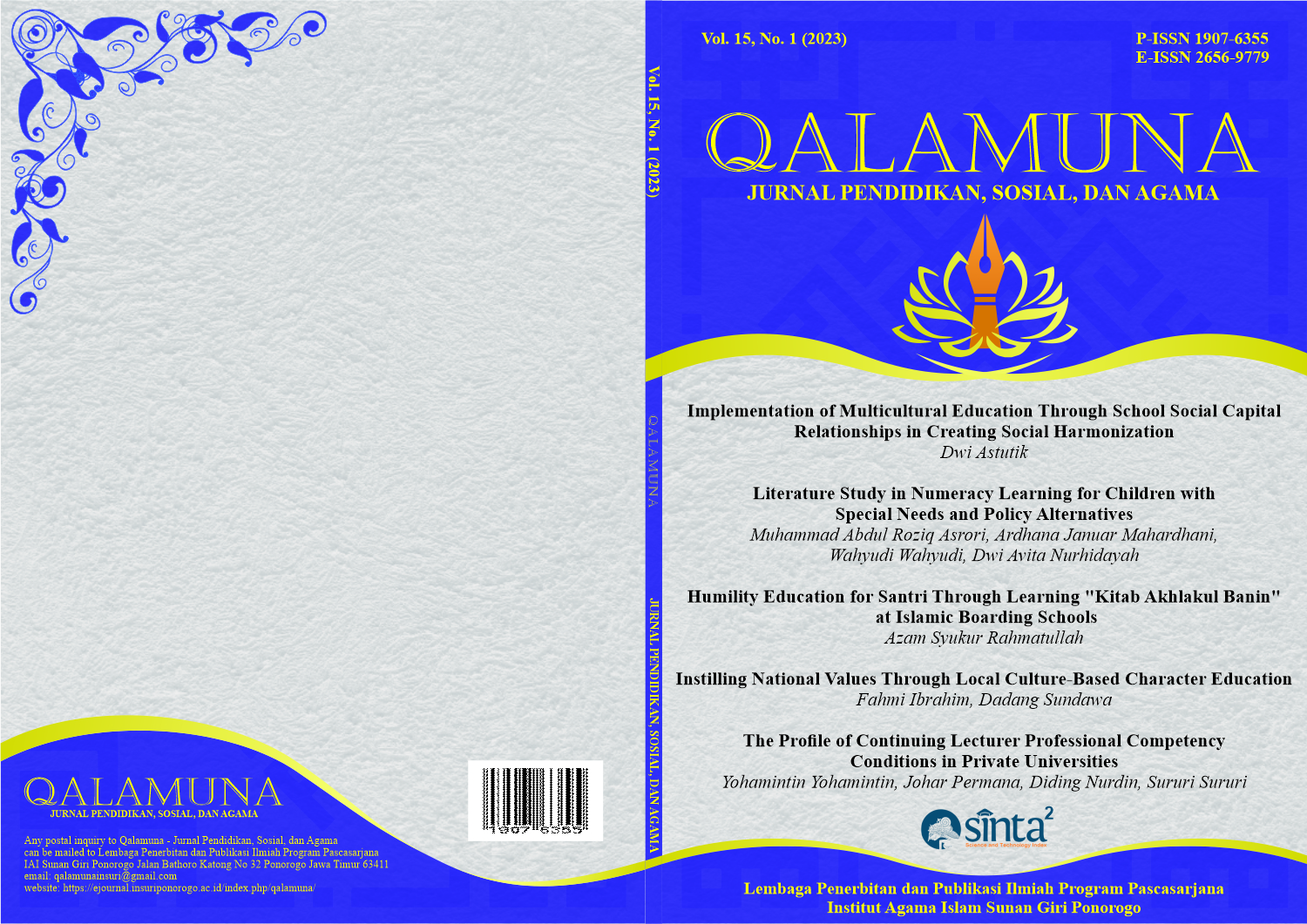Educational Thought of Kyai Abbas: A Response to the National Awakening and the Struggle for Independence
DOI:
https://doi.org/10.37680/qalamuna.v15i1.2572Keywords:
Educational Kyai Abbas, Militancy Students, Independence MovementAbstract
In this study, the researcher aims to discuss the adaptation efforts of Kyai Abbas in the world of Education. Kyai Abbas, as the central figure of West Java in the struggle of November 10, 1945, in Surabaya has made a major contribution to the world of educational thought. This is what becomes interesting to discuss. The movement of the independence struggle carried out by Kyai Abbas through education had a great influence on the birth of a cadre of scholars and freedom fighters for the country. Kyai Abbas maintains religious knowledge on the one hand and educates millions of students to defend the homeland. Pesantren became the basis of movement for the fighters in freeing their country from colonization. The approach used in this study is a literature study with inductive analysis. The procedure used in this study was carried out in three stages, namely orientation, exploration, and focused study. However, previous researchers first determine the object of study research by determining the material and formal objects of research. This is done so that research researchers remain focused on the problem under study, namely the problem of educational thinking Kyai Abbas. From the results of the discussion, the researchers managed to reveal the study's findings, that Kyai Abbas managed to make agitation efforts against a condition of colonization through the line of educational thought. Buntet Pesantren Cirebon is not only a place to print ulama cadres but also print fighters for the country that is being colonized. Kyai Abbas built the foundation for Buntet Pesantren by producing alumni with religious knowledge and militancy in defending the homeland.
References
Aziz, M. (2016). Kiai Abbas Buntet: Kiai Sufi Pejuang Negeri. Nu Online. https://www.nu.or.id/fragmen/kiai-abbas-buntet-kiai-sufi-pejuang-negeri-bllKv
Bizawie, Z. M. (2014). Lasykar Ulama Santri dan Resolusi Jihad: Garda depan Menegakkan Indonesia (1945-1949). Tangerang: Pustaka Compass.
Chowas, A. S. (2019). ‘CINA’ YANG MAHIR NAHWU SHOROF.
Darmalaksana, W. (2020). Metode Penelitian Kualitatif Studi Pustaka dan Studi Lapangan. Pre-Print Digital Library UIN Sunan Gunung Djati Bandung, 1–6.
Dhofier, Z. (1982). Tradisi pesantren: Studi tentang pandangan hidup kyai. Lp3Es.
Falah, M. (2008). Riwayat Perjuangan KH Abdul Halim. Jawa Barat: Masyarakat Sejarawan Indonesia Cabang Jawa Barat.
Fathi, M. R., & Wajdi, F. (2004). Pesantren Buntet Melintas Sejarah. Cirebon: An-Nur Press.
Gonggong, A. (1985). HOS Tjokroaminoto. Departemen Pendidikan dan Kebudayaan, Direktorat Sejarah dan Nilai ….
Halpern, A. M. (1961). The Crescent and the Rising Sun: Indonesian Islam under the Japanese Occupation, 1942–1945. By Harry J. Benda. The Hague and Bandung: W. van Hoeve Ltd., 1958. xiv, 320. Notes, Bibliography, Index. $5.50. The Journal of Asian Studies, 20(2), 238–239.
Hamidah, L. (2020). Memperkenalkan Sejarah Pahlawan Nasional KH Samanhudi bagi Peserta Didik MI/SD di Indonesia. El-Ibtidaiy: Journal of Primary Education, 3(2), 101–111.
Harahap, N. (2014). Penelitian Kepustakaan. 08(01), 63–73. http://journal.um-surabaya.ac.id/index.php/JKM/article/view/2203
Jabar, C. S. A. (2008). Human Instrument dalam Penelitian Kualitatif: Sebuah Konsep. Penelitian Pendidikan, 1(1), 1–23. http://staffnew.uny.ac.id/upload/132243758/penelitian/konsep+human+instrument.pdf
Madjid, N. (1997). Bilik-bilik pesantren: sebuah potret perjalanan. Paramadina.
Mahanum, M. (2021). Tinjauan Kepustakaan. ALACRITY : Journal of Education, 1(2), 1–12. https://doi.org/10.52121/alacrity.v1i2.20
Muhaimin, A. G. (1995). The Islamic traditions of Cirebon: ibadat and adat among Javanese muslims.
Muhaimin, A. G. (2006). The Islamic Traditions of Cirebon: Ibadat and Adat Among Javanese Muslims: Ibadat and Adat Among Javanese Muslims. ANU Press.
Mustaqim, A. (2016). MODEL PENELITIAN TOKOH (Dalam Teori dan Aplikasi). Jurnal Studi Ilmu-Ilmu Al-Qur’an Dan Hadis, 15(2), 201. https://doi.org/10.14421/qh.2014.15201
Nuris, A. (2017). Ahmad Dahlan Dan Pesantren: Gerakan Pembaharuan Pendidikan, Dakwah, Dan Pemberdayaan Masyarakat Di Indonesia. Dirosat: Journal of Islamic Studies, 1(2), 243–258.
Poesponegoro, M. D., & Notosusanto, N. (1990). Sejarah nasional Indonesia: III. Departemen Pendidikan dan Kebudayaan.
Rifai, M. (2010). KH Wahab Hasbullah: biografi singkat, 1888-1971. Garasi House of Book.
Rosyidin, M. A. (2016). Kiai Abbas Buntet, Kiai Kharismatik Pejuang Revolusi. Tebuireng Online. https://tebuireng.online/kiai-abbas-buntet-kiai-kharismatik-pejuang-revolusi/
Soelistyarini, T. D. (2013). Pedoman Penyusunan Tinjauan Pustaka dalam Penelitian dan Penulisan Ilmiah. Universitas Airlangga, 1–6. https://www.academia.edu/7304163/Pedoman_Penyusunan_Tinjauan_Pustaka_dalam_Penelitian_dan_Penulisan_Ilmiah
Steenbrink, K. A. (1986). Pesantren madrasah sekolah. Jakarta: Lp3es.
Subandi. (2011). Qualitative Description as One Method in Performing Arts Study. Harmonia, 19, 173–179.
Van Bruinessen, M. (1995). Kitab kuning pesantren dan tarekat: tradisi-tradisi islam di Indonesia. Mizan.
Ziemek, M. (1986). Pesantren dalam perubahan Sosial. Perhimpunan Pengembangan Pesantren dan Masyarakat (P3M).
Downloads
Published
How to Cite
Issue
Section
License
Authors who submit manuscript retain its copyright and grant publisher right of first publication licensed under a Creative Commons Attribution-ShareAlike 4.0 International License (CC BY-SA 4.0) that allows others to access (search, read, download, and cite), share (copy and redistribute the material in any medium or format) and adapt (remix, transform, and build upon any material) the work for any lawful purpose, even commercially with an acknowledgement of the work's authorship and initial publication in Qalamuna: Jurnal Pendidikan, Sosial, dan Agama.












